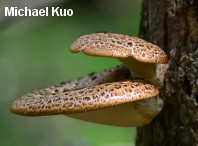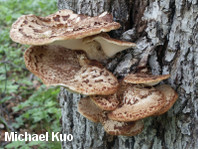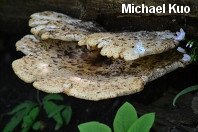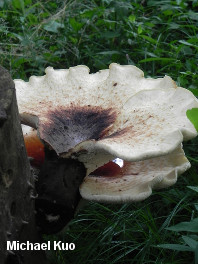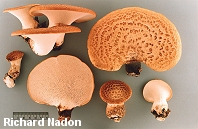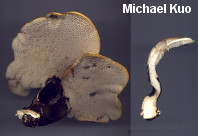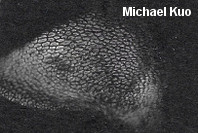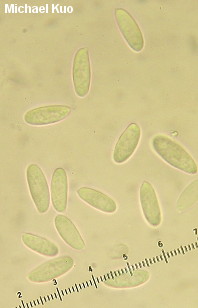| Major Groups > Polypores > Stemmed, Pale-Fleshed > Polyporus squamosus |

|
Polyporus squamosus [ Basidiomycota > Polyporales > Polyporaceae > Polyporus . . . ] by Michael Kuo This common polypore is frequently encountered by morel hunters in the spring, who find it growing on hardwood stumps, logs, and standing trees. It is easily recognized by its large size, its colors, the flattened scales on the cap, the black and velvety stem base (present on mature specimens), and its strongly mealy odor. Although Polyporus squamosus is annual (unlike some of the perennial, woody-fleshed polypores), its fruiting bodies are quite durable and, given the right conditions, can last for many months. When this happens the mushrooms can look very different, and in fall specimens are sometimes encountered in which the scales have all-but vanished and the caps are essentially white, with a reddish black area over the center. At the time of this writing (April, 2015) the genus "Polyporus" is headed for major changes; DNA studies (for example Sotome et al., 2008) have made it clear that the genus we thought we had a handle on is actually fairly incoherent, requiring a number of taxonomic changes. However, as a friend of mine puts it, mycologists have been working "around the edges" of the problem in order to avoid the big taxonomic headache that someone will eventually have to suffer: deciding what species should rightly be the "type species" for the genus Polyporus. The candidates for which species should serve as the representative for the genus are Polyporus tuberaster and Polyporus brumalis—and the problem is that these two species are not closely related, which means that if one of them (and its close relatives) is a Polyporus, the other (and its relatives) will need a new generic name. Our friend Polyporus squamosus belongs with the tuberaster group, so it will keep its name if Polyporus tuberaster is agreed upon as the type species—but it will need a new genus name if Polyporus brumalis wins out. Description: Ecology: Saprobic on decaying hardwood logs and stumps, and parasitic on living hardwoods (in the Midwest and eastern North America it is found on a wide variety of hardwoods, but it is especially fond of silver maple and box elder; in western North America it appears primarily on quaking aspen); causing a white heartrot; growing alone or, more often, in clusters of two or three; annual; typically found in spring, but also sometimes found in summer and fall (even in winter, during warm spells); widely distributed in North America but much more common east of the Rocky Mountains. The illustrated and described collections are from Illinois and Québec. Cap: 5–30 cm across; 1–4 cm thick; variable in outline but generally semicircular, kidney-shaped, or fan-shaped; broadly convex, becoming flat, shallowly depressed, or deeply depressed; dry; pale tan to creamy yellowish, with an overlay of large, flattened, brown to blackish scales that are vaguely radially arranged; in old age sometimes whitish with reddish to black scales, or developing a black area over the center; the thin margin initially incurved, later even. Pore Surface: Running down the stem; whitish to creamy, becoming yellowish with old age; not bruising; pores large at maturity, angular, and frequently irregular; tube layer up to 1.5 cm deep, not readily separable as a layer. Stem: 2–8 cm long; 1–4 cm thick; usually off-center or lateral; whitish above, but soon becoming covered, from the base up, with a velvety, dark brown to black tomentum; solid. Flesh: Thick; soft when young but soon becoming corky and tough, especially in the stem; white; unchanging when sliced. Odor and Taste: Strongly mealy. Spore Print: White. Microscopic Features: Spores 11–15 x 4–5 µm; subcylindric to long-ellipsoid; smooth; hyaline in KOH; inamyloid. Hymenial cystidia absent. Hyphal system dimitic. REFERENCES: (Hudson, 1778) Fries, 1821. (Saccardo, 1888; Overholts, 1953; Smith, Smith & Weber, 1981; Arora, 1986; Gilbertson & Ryvarden, 1987; Phillips, 1991/2005; Lincoff, 1992; Nunez & Ryvarden, 1995; Barron, 1999; Roody, 2003; McNeil, 2006; Kuo, 2007; Sotome et al., 2008; Kuo & Methven, 2014.) Herb. Kuo 04199501, 04209501, 09040101. This site contains no information about the edibility or toxicity of mushrooms. |
© MushroomExpert.Com |
|
Cite this page as: Kuo, M. (2015, April). Polyporus squamosus. Retrieved from the MushroomExpert.Com Web site: http://www.mushroomexpert.com/polyporus_squamosus.html |
